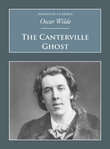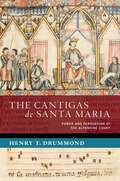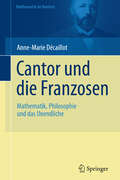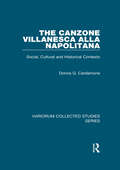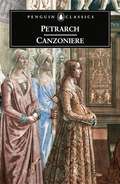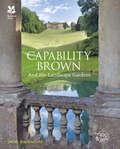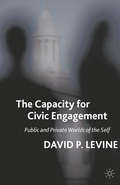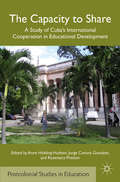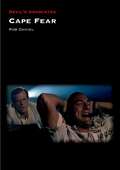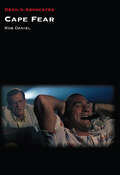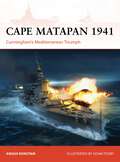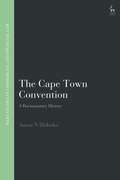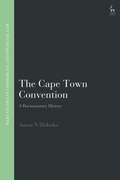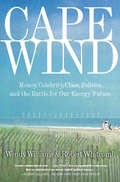- Table View
- List View
The Canterville Ghost: Nonsuch Classics (English Bookmarks Ser.)
by Oscar WildeOscar Wilde's story of the The Canterville Ghost tells the tale of a malevolent ghost who discovers there is no peace to be found when a rumbustious American family take over his ancestral home. This classic tale by one of the 19th century's most celebrated wits is here reproduced in a stunning little book with stylish illustrations which perfectly capture the atmosphere and imagination of the story. An ideal gift for young readers who enjoy classic stories.
The Cantigas de Santa Maria: Power and Persuasion at the Alfonsine Court (NEW CULTURAL HISTORY OF MUSIC SERIES)
by Henry T. DrummondAlfonso X (1221-84) ruled over the Crown of Castile from 1252 until his death. Known as "the Wise," he oversaw the production of a wealth of literature in his scriptorium. One of the most impressive of these literary outputs is the collection of songs known as the Cantigas de Santa Maria, which by most counts comprises 429 songs preserved in four manuscripts. The miracle songs (or cantigas de miragre) form the focus of this book. While the Cantigas have been the subject of much scholarly attention, only a handful of studies have looked at the repertory through an interdisciplinary lens. Fewer still have probed how the Cantigas use the power of song as a communicative medium, one that functions as a social tool within the erudite environment of the Alfonsine court. This book offers a new perspective to the song collection, probing how the Cantigas use their music and text, together with rhetorical devices, to communicate with their desired audience. Author Henry T. Drummond builds upon previous methodologies, adopting a novel and holistic assessment of the songs' melodies, poetic features, and narrative logic to assess a wide selection of songs. He presents a nuanced understanding of a song form that effectively conveys its narratives to its listeners via a diverse combination of tools, embracing medieval rhetoric, rhyme-based play, and song's inherent ludic potential. Such devices, Drummond argues, allow for the Cantigas to loom large as propaganda pieces, designed to dignify Alfonso X through an elaborately devised courtly ritual.
The Cantigas de Santa Maria: Power and Persuasion at the Alfonsine Court (NEW CULTURAL HISTORY OF MUSIC SERIES)
by Henry T. DrummondAlfonso X (1221-84) ruled over the Crown of Castile from 1252 until his death. Known as "the Wise," he oversaw the production of a wealth of literature in his scriptorium. One of the most impressive of these literary outputs is the collection of songs known as the Cantigas de Santa Maria, which by most counts comprises 429 songs preserved in four manuscripts. The miracle songs (or cantigas de miragre) form the focus of this book. While the Cantigas have been the subject of much scholarly attention, only a handful of studies have looked at the repertory through an interdisciplinary lens. Fewer still have probed how the Cantigas use the power of song as a communicative medium, one that functions as a social tool within the erudite environment of the Alfonsine court. This book offers a new perspective to the song collection, probing how the Cantigas use their music and text, together with rhetorical devices, to communicate with their desired audience. Author Henry T. Drummond builds upon previous methodologies, adopting a novel and holistic assessment of the songs' melodies, poetic features, and narrative logic to assess a wide selection of songs. He presents a nuanced understanding of a song form that effectively conveys its narratives to its listeners via a diverse combination of tools, embracing medieval rhetoric, rhyme-based play, and song's inherent ludic potential. Such devices, Drummond argues, allow for the Cantigas to loom large as propaganda pieces, designed to dignify Alfonso X through an elaborately devised courtly ritual.
Cantor und die Franzosen: Mathematik, Philosophie und das Unendliche (Mathematik im Kontext)
by Anne-Marie DécaillotEnde des 19. Jahrhunderts, als Georg Cantor in Halle die Mengenlehre entwickelte, korrespondierte der Mathematiker lebhaft mit zahlreichen französischen Fachkollegen. Diese Briefe nimmt die Autorin zur Grundlage, um im Detail zu beschreiben, wie die Briefpartner um mathematische Begriffe gerungen haben. Eingebettet in den historischen Kontext wird so ein faszinierender Moment in der Geschichte der Mathematik wieder lebendig.
The Canvas of the World
by Antonin VarenneArriving at the Paris Exposition of 1900, Aileen Bowman is an unusual woman. A journalist in her mid-thirties, unmarried, independent, she has been sent to cover the event for the New York Tribune, but the arrival of this woman who is unafraid to speak her mind, liberated from constraints of her gender and class, soon creates a stir in the city of lights. In the course of a story that immerses us in the heart of the city under construction, from the emerging metropolis to neighborhood brothels frequented by artists and bohemians, the singular personality of Aileen merges with this city that suddenly finds itself at the heart of the world.
The canzone villanesca alla napolitana: Social, Cultural and Historical Contexts
by Donna G. CardamoneThe printed debut of the canzone villanesca alla napolitana occurred on 24 October 1537, in Naples. Fifteen anonymous 'rustic songs' were published by Johannes de Colonia in a pocket-sized anthology with a cover featuring three women with hoes tilling the soil. The adjective villanesca (from villano or peasant) in the strict sense of the word means rustic or crude, but in this new context it also intimates that Neapolitan poet-musicians had been affected by the instinctive lyrical traditions of everyday people. The articles in this volume trace the Neapolitan origins of this song form, and its subsequent development as it spread quickly throughout Italy in a succession of editions published in Venice and Rome, providing a diverse repertory of lively songs to amuse the privileged that held and attended academies. Several studies focus on key figures in this process, notably Ferrante Sanseverino, Prince of Salerno, and Orlando di Lasso. At the same time the author relates these developments to the contemporary political context, notably the rivalry of Spain and France for control of the Kingdom of Naples.
The canzone villanesca alla napolitana: Social, Cultural and Historical Contexts
by Donna G. CardamoneThe printed debut of the canzone villanesca alla napolitana occurred on 24 October 1537, in Naples. Fifteen anonymous 'rustic songs' were published by Johannes de Colonia in a pocket-sized anthology with a cover featuring three women with hoes tilling the soil. The adjective villanesca (from villano or peasant) in the strict sense of the word means rustic or crude, but in this new context it also intimates that Neapolitan poet-musicians had been affected by the instinctive lyrical traditions of everyday people. The articles in this volume trace the Neapolitan origins of this song form, and its subsequent development as it spread quickly throughout Italy in a succession of editions published in Venice and Rome, providing a diverse repertory of lively songs to amuse the privileged that held and attended academies. Several studies focus on key figures in this process, notably Ferrante Sanseverino, Prince of Salerno, and Orlando di Lasso. At the same time the author relates these developments to the contemporary political context, notably the rivalry of Spain and France for control of the Kingdom of Naples.
Canzoniere (European Writers Ser.)
by PetrarchThe 'Canzoniere', a sequence of sonnets and other verse forms, were written over a period of about 40 years. They describe Petrarch's intense love for Laura, whom he first met in Avignon in 1327, and her effect on him after she died in 1348. The collection is an examination of the poet's growing spiritual crisis, and also explores important contemporary issues such as the role of the papacy and religion.
Cap-Badges of the British Army 1939-45
by G L AldersonThe British Army has always set great store by its cap badges, which , in miniature, encapsulated the history and traditions of the units that wore them. They were worn with pride by the County regiments (that formed the bulk of the infantry) throughout the two world wars. Here is a comprehensive illustrated collection of the cap badges of the Second World War, the images taken from the author’s own collection. The commentary on each badge explains the joining together of battalions as the war progressed and a regimental index makes finding the badges easy. This is a complex subject clarified in one volume for the first time.
Capability Brown: And His Landscape Gardens (National Trust History And Heritage Ser.)
by Sarah RutherfordOne of the most remarkable men of the 18th century, Lancelot ‘Capability’ Brown was known to many as ‘The Omnipotent Magician’ who could transform unpromising countryside into beautiful parks that seemed to be only the work of nature.
Capacity: The History, the World, and the Self in Contemporary Art and Criticism (Critical Voices in Art, Theory and Culture)
by Thomas McEvilleyFirst Published in 1997. Routledge is an imprint of Taylor & Francis, an informa company.
Capacity: The History, the World, and the Self in Contemporary Art and Criticism (Critical Voices in Art, Theory and Culture)
by Thomas McEvilleyFirst Published in 1997. Routledge is an imprint of Taylor & Francis, an informa company.
The Capacity for Civic Engagement: Public and Private Worlds of the Self
by D. LevineHow do we form a connection to the ideals and institutions of public life? This connection is sometimes expressed in the language of civic engagement, public service, and commitment to the public good. While we do not lack for literature to guide us in thinking about public life, we have less to call on when our problem is not only to explore public ideals and institutions, but also to consider the nature and origin of our capacity to make a connection with and find meaning in those institutions and ideals. Levine explores the nature and origin of this capacity to form a connection and find meaning.
The Capacity to Share: A Study of Cuba’s International Cooperation in Educational Development (Postcolonial Studies in Education)
by Anne Hickling-Hudson, Jorge Corona González, and Rosemary PrestonThis discussion of Cuba's international policies in education shows how Cuba shares its educational resources with other countries. The postcolonial critique underlying the book explores Cuba's role in relation to how the disengagement from colonial legacies in education is taking place in many countries.
Cape Fear (Devil's Advocates)
by Rob DanielMartin Scorsese’s Cape Fear (1991) opens with a shot of water and climaxes on a raging river. Despite, or perhaps because of, the film’s great commercial success, critical analysis of the film typically does not delve beneath the surface of Scorsese’s first major box office hit. As it reaches its 30th anniversary, Cape Fear is now ripe for a full appraisal. The remake of J. Lee Thompson’s 1962 Cape Fear was originally conceived as a straightforward thriller intended for Steven Spielberg. Author Rob Daniel investigates the fascinating ways Scorsese’s style and preoccupations transform his version into a horror epic. The director’s love of fear cinema, his Catholicism and filmmaking techniques shift Cape Fear into terrifying psychological and psychosexual waters. The analysis also examines the influence of Gothic literature and fairy tales, plus how academic approaches to genre aid an understanding of the film.
Cape Fear (Devil's Advocates)
by Rob DanielMartin Scorsese’s Cape Fear (1991) opens with a shot of water and climaxes on a raging river. Despite, or perhaps because of, the film’s great commercial success, critical analysis of the film typically does not delve beneath the surface of Scorsese’s first major box office hit. As it reaches its 30th anniversary, Cape Fear is now ripe for a full appraisal. The remake of J. Lee Thompson’s 1962 Cape Fear was originally conceived as a straightforward thriller intended for Steven Spielberg. Author Rob Daniel investigates the fascinating ways Scorsese’s style and preoccupations transform his version into a horror epic. The director’s love of fear cinema, his Catholicism and filmmaking techniques shift Cape Fear into terrifying psychological and psychosexual waters. The analysis also examines the influence of Gothic literature and fairy tales, plus how academic approaches to genre aid an understanding of the film.
Cape Matapan 1941: Cunningham’s Mediterranean Triumph (Campaign #397)
by Angus KonstamThe first ever illustrated study of the largest and most significant clash between the Royal Navy and the Italian Regia Marina.The Battle of Matapan witnessed the first use of decisive new technologies to bring about a stunning British victory over the Italian Navy. The Allies had tapped into the Ultra coded messages sent by the Axis powers, and the battle witnessed the use of radar and carrier-based air strikes to bring about a critical night action. The result was the most decisive engagement of the Mediterranean naval war.Written by renowned naval historian Angus Konstam, this book offers for the first time a unique and fully illustrated exploration of the battle. It also examines why, despite the emphatic and decisive Royal Navy victory, the Allies failed to capitalize on the strategic advantage earned in the months that followed. Battlescene artworks bring to life the cruiser clashes early on 28 March off Gavdos, the Fleet Air Arm attacks on the Italian fleet, and the 28/29 March night action that resulted in the destruction of Admiral Carlo Cattaneo's ships – Italy's worst naval defeat. The progress of the action from the initial Operation Gaudo sweep by Italy's powerful battle fleet towards Crete (aimed at disrupting Allied convoys) to the events of the climactic battle itself is revealed in detailed maps.
Cape Matapan 1941: Cunningham’s Mediterranean Triumph (Campaign #397)
by Angus KonstamThe first ever illustrated study of the largest and most significant clash between the Royal Navy and the Italian Regia Marina.The Battle of Matapan witnessed the first use of decisive new technologies to bring about a stunning British victory over the Italian Navy. The Allies had tapped into the Ultra coded messages sent by the Axis powers, and the battle witnessed the use of radar and carrier-based air strikes to bring about a critical night action. The result was the most decisive engagement of the Mediterranean naval war.Written by renowned naval historian Angus Konstam, this book offers for the first time a unique and fully illustrated exploration of the battle. It also examines why, despite the emphatic and decisive Royal Navy victory, the Allies failed to capitalize on the strategic advantage earned in the months that followed. Battlescene artworks bring to life the cruiser clashes early on 28 March off Gavdos, the Fleet Air Arm attacks on the Italian fleet, and the 28/29 March night action that resulted in the destruction of Admiral Carlo Cattaneo's ships – Italy's worst naval defeat. The progress of the action from the initial Operation Gaudo sweep by Italy's powerful battle fleet towards Crete (aimed at disrupting Allied convoys) to the events of the climactic battle itself is revealed in detailed maps.
Cape of Torments: Slavery and Resistance in South Africa (Routledge Library Editions: Slavery #4)
by Robert RossCape of Torments, first published in 1983, is a detailed examination of slavery in the Colony of the Cape of Good Hope. It describes the reactions of the slaves to their conditions of slavery, concentrating on those aspects of their lives which their masters considered criminal, and above all on the large numbers of occasions when slaves ran away in an attempt to start a new life elsewhere. The book examines Cape society and slave organization; the complex relations between slaves and the other groups of population at the Cape – Khoisan, Xhosa, Sotho-Tswana, Dutch East India Co servants and sailors – and the opportunities for escape; major uprisings and rebellions. The major theme of the book is the extent to which the Cape slaves were able to build a culture of their own, and the legacy of slavery to their descendants in modern South Africa.
Cape of Torments: Slavery and Resistance in South Africa (Routledge Library Editions: Slavery #4)
by Robert RossCape of Torments, first published in 1983, is a detailed examination of slavery in the Colony of the Cape of Good Hope. It describes the reactions of the slaves to their conditions of slavery, concentrating on those aspects of their lives which their masters considered criminal, and above all on the large numbers of occasions when slaves ran away in an attempt to start a new life elsewhere. The book examines Cape society and slave organization; the complex relations between slaves and the other groups of population at the Cape – Khoisan, Xhosa, Sotho-Tswana, Dutch East India Co servants and sailors – and the opportunities for escape; major uprisings and rebellions. The major theme of the book is the extent to which the Cape slaves were able to build a culture of their own, and the legacy of slavery to their descendants in modern South Africa.
The Cape Town Convention: A Documentary History (Hart Studies in Commercial and Financial Law)
by Anton DidenkoThis book is the first detailed and comprehensive research of the history of the Cape Town Convention and its protocols. It critically engages with the challenges faced by the developers of this treaty, analyses thousands of pages of archived materials and derives important lessons for the development of transnational commercial law globally. The book is an invaluable addition to the existing literature on the Cape Town Convention. It also informs the debate about harmonisation of secured transactions regimes generally, and as such will be of interest to academics, legal practitioners and the judiciary involved in secured transactions law around the world. Practising lawyers will better understand the rationale behind the key provisions of the Cape Town Convention, while the treaty-making lessons will assist governmental officials, representatives of international organisations and legal advisors engaged in harmonisation of commercial law.The text covers all four protocols to the Cape Town Convention, including the MAC Protocol adopted on 22 November 2019 in Pretoria.
The Cape Town Convention: A Documentary History (Hart Studies in Commercial and Financial Law)
by Anton DidenkoThis book is the first detailed and comprehensive research of the history of the Cape Town Convention and its protocols. It critically engages with the challenges faced by the developers of this treaty, analyses thousands of pages of archived materials and derives important lessons for the development of transnational commercial law globally. The book is an invaluable addition to the existing literature on the Cape Town Convention. It also informs the debate about harmonisation of secured transactions regimes generally, and as such will be of interest to academics, legal practitioners and the judiciary involved in secured transactions law around the world. Practising lawyers will better understand the rationale behind the key provisions of the Cape Town Convention, while the treaty-making lessons will assist governmental officials, representatives of international organisations and legal advisors engaged in harmonisation of commercial law.The text covers all four protocols to the Cape Town Convention, including the MAC Protocol adopted on 22 November 2019 in Pretoria.
Cape Wind: Money, Celebrity, Class, Politics, and the Battle for Our Energy Future on Nantucket Sound
by Wendy Williams Robert WhitcombWhen Jim Gordon set out to build a wind farm off the coast of Cape Cod, he knew some people might object. But there was a lot of merit in creating a privately funded, clean energy source for energy-starved New England, and he felt sure most people would recognize it eventually. Instead, all Hell broke loose. Gordon had unwittingly challenged the privileges of some of America's richest and most politically connected people, and they would fight him tooth and nail, no matter what it cost, and even when it made no sense.Cape Wind is a rollicking tale of democracy in action and plutocracy in the raw as played out among colorful and glamorous characters on one of our country's most historic and renowned pieces of coastline. As steeped in American history and local color as The Prince of Providence; as biting, revealing and fun as Philistines at the Hedgerow, it is also a cautionary tale about how money can hijack democracy while America lags behind the rest of the developed world in adopting clean energy.
Capetian France 987–1328
by Elizabeth M Hallam Charles WestCapetian France 987–1328 is an authoritative overview of the country’s development across four centuries, with a focus on changes to the political, religious, social and cultural climate during this period. When Hugh Capet took the throne of France in 987, his powers were weak and insignificant, but from an inauspicious beginning he founded a dynasty that was to last over 300 years and that came to dominate western Europe. This carefully updated third edition draws extensively on new scholarship that has emerged since the previous edition. It contains images, maps, family trees and a discussion of key sources, allowing the reader to develop a strong contextual knowledge as well as a greater connection with the material world of the period. Maintaining a balance between a compelling narrative and an in-depth examination of central themes of the age, Capetian France 987–1328 provides a comprehensive account of this significant era within France’s history and is essential reading for all students of medieval France and Europe.
Capetian France 987–1328
by Charles West Elizabeth M HallamCapetian France 987–1328 is an authoritative overview of the country’s development across four centuries, with a focus on changes to the political, religious, social and cultural climate during this period. When Hugh Capet took the throne of France in 987, his powers were weak and insignificant, but from an inauspicious beginning he founded a dynasty that was to last over 300 years and that came to dominate western Europe. This carefully updated third edition draws extensively on new scholarship that has emerged since the previous edition. It contains images, maps, family trees and a discussion of key sources, allowing the reader to develop a strong contextual knowledge as well as a greater connection with the material world of the period. Maintaining a balance between a compelling narrative and an in-depth examination of central themes of the age, Capetian France 987–1328 provides a comprehensive account of this significant era within France’s history and is essential reading for all students of medieval France and Europe.
